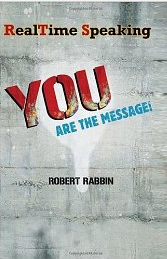Review of RealTime Speaking: YOU Are The Message by Robert Rabbin
Public speaking. For some, these can be the two most feared words. Yet for others—like Robert Rabbin—it’s a piece of cake.
Rabbin is renowned around the globe for his public speaking, leadership, and self-awareness seminars. He has taught thousands of people—from business owners to teachers, from politicians to musicians, from executives to spiritual leaders—how to communicate so their point is made and how to do it with confidence.
In the paperback, RealTime Speaking: YOU Are The Message, Rabbin unravels for readers what exactly is public speaking, what common fears are associated with it, and how to push past these fears and discover comfortable communication.
What is Public Speaking?
 Public speaking, defined by Rabbin in YOU Are The Message, is “speaking with anyone other than yourself, regardless of numbers, venue, or purpose.” He also maintains that it is not about what words you say, but about your message, your confidence, your intent, and all the non-verbal cues you give off.
Public speaking, defined by Rabbin in YOU Are The Message, is “speaking with anyone other than yourself, regardless of numbers, venue, or purpose.” He also maintains that it is not about what words you say, but about your message, your confidence, your intent, and all the non-verbal cues you give off.
I like Rabbin’s definition of public speaking. It can apply to anyone—from a newly hired employee meeting his or her new coworkers, to a new student in school, to someone just trying to make a friend, to a CEO trying to convince his corporation to go in a new direction—the situations are endless. And in each situation, communication is imperative.
You may also be interested in reading > Robert’s Spiritual Activism Articles
Common Fears of Speaking in Public
I’ve always dreaded speaking in public—whether in front of peers, coworkers, strangers, and even my own family. I made a list of just a few fears I have when it comes to speaking in front of or to other people: Am I blushing? Do I know what I’m talking about? Am I saying something I can’t back up? Where do I look? Am I doing it right?
According to Rabbin, these fears are not unique to me: in fact, there are many common fears people share about public speaking. Rabbin notes that fear of public speaking is a “self-inflicted wound” brought on by negative experiences with self-expression. When learning to communicate, people can pick up on things like rejection or confusion, and sometimes we can carry these fears with us, thus affecting communication experiences down the road.
But just as easy as it is to learn these fears, Rabbin’s book discusses how easy it is to unlearn them and become an authentic, credible communicator.
Learning to “Live Out Loud”
The book consists of personal essays written by former participants of Rabbin’s many seminars and presentations. Rabbin responds to each essay using related concept from his RealTime program and his own personal experiences. These essays are well-written and cover different points of view, but all relate to the same thing: how to learn to speak effectively in public.
 Rabbin includes various exercises throughout the book that readers can do to help unlock their potential. He also discusses different steps to becoming a more effective communicator, like distinguishing between signal and noise, understanding authenticity, the five steps to practice while public speaking, and the five Ps of giving a speech someone will listen to.
Rabbin includes various exercises throughout the book that readers can do to help unlock their potential. He also discusses different steps to becoming a more effective communicator, like distinguishing between signal and noise, understanding authenticity, the five steps to practice while public speaking, and the five Ps of giving a speech someone will listen to.
Rabbin’s book certainly helped me take a different look at myself as a communicator, and gave me new tools I can use to change my own perspective—and ultimately my life. For anyone with a hesitancy of speaking publicly, or for anyone wanting “full access to one’s inexhaustible inner resource of creative and expressive power,” this book is an invaluable resource.
To learn more visit Amazon > Real Time Speaking








